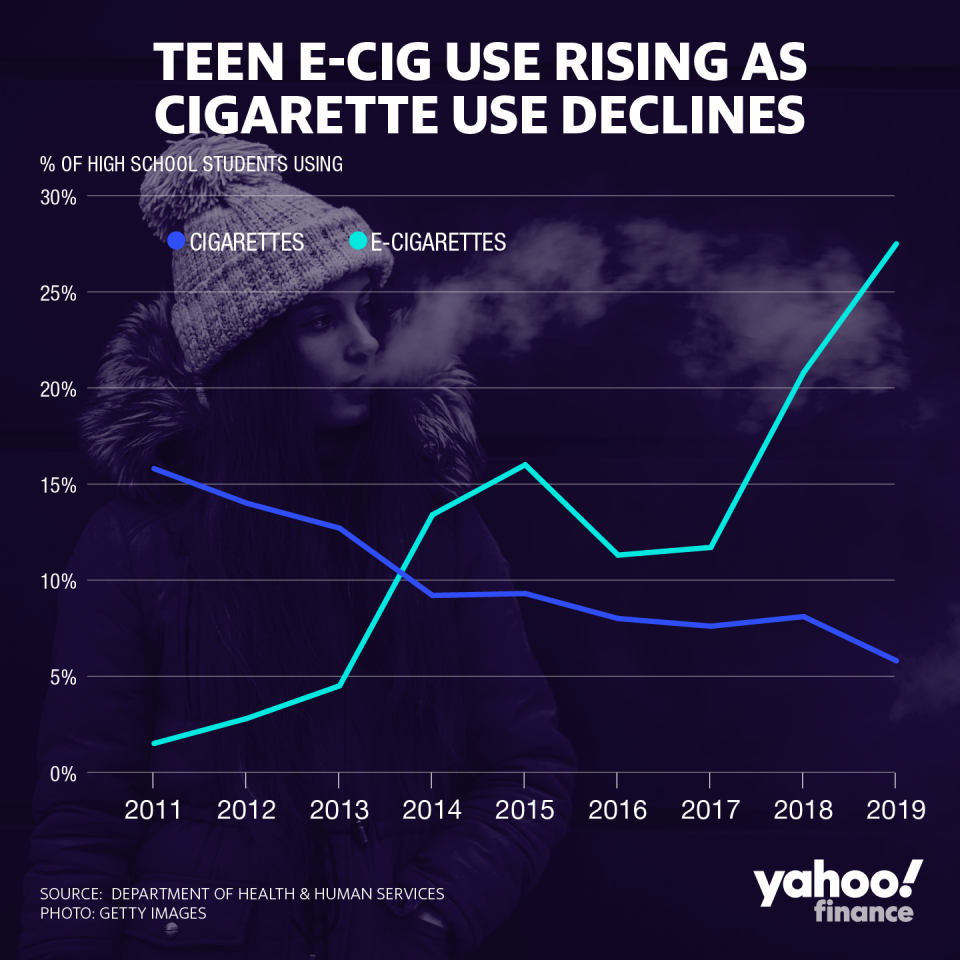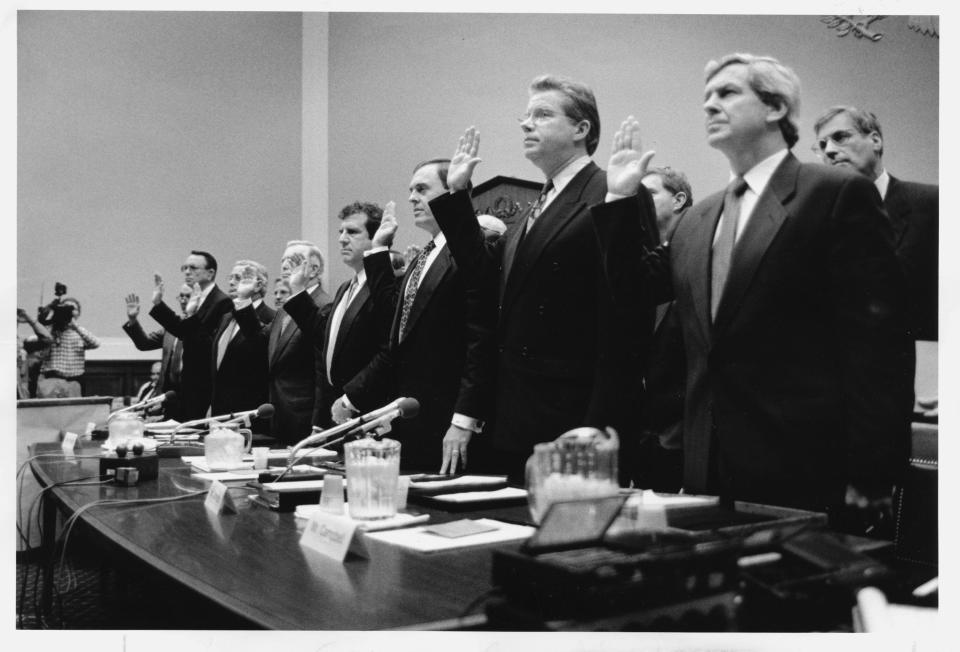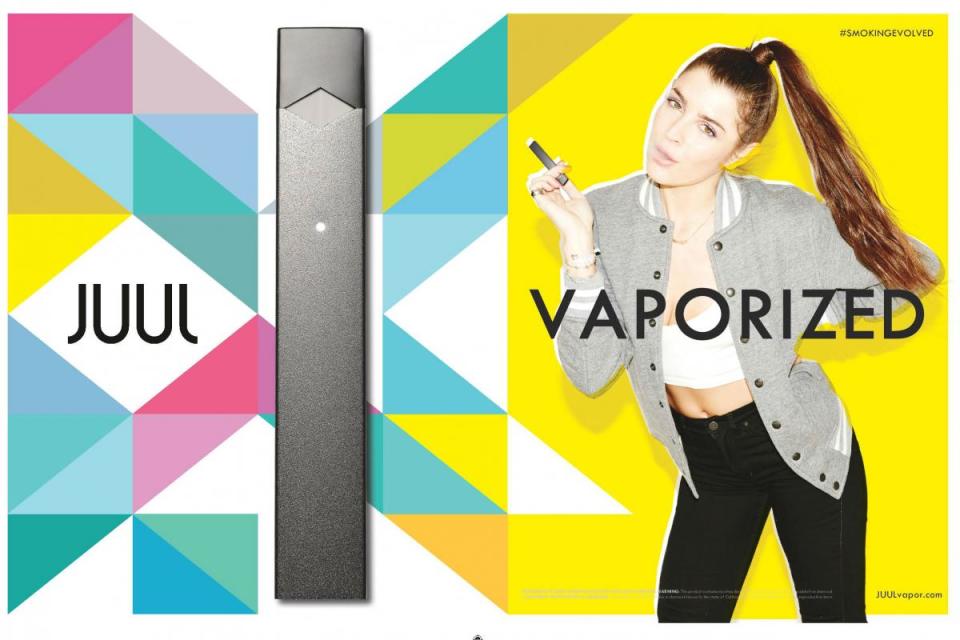Expert witnesses in Big Tobacco cases explain why Juul doesn’t have a ‘get out of jail free card’
Twenty-five years ago, seven top Big Tobacco executives stood before Congress — under oath — in the now infamous scene of brash public deceit and passed the microphone from one CEO to another to deliver the industry’s largest collective lie.
Despite knowing full well at the time that their nicotine-containing cigarettes were addictive, all seven executives unanimously defied the mounting scientific evidence against their products to deliver their collective position: “I believe that nicotine is not addictive.”
Two decades later, with mounting lawsuits and heightened scrutiny over health concerns, it’s nearly impossible not to draw a direct parallel to the situation now ensnaring the country’s largest vaping companies. Not only has Big Vaping boomed by attempting to capitalize on replacing cancer-causing cigarettes, it’s also ridden a wave of pitching e-cigarettes as safe products and downplayed evidence to the contrary.
A July congressional hearing featuring executives from Juul Labs, the leading U.S. e-cigarette manufacturer that controls about 75% of the market, evoked the historical Big Tobacco grilling when the chairman of the investigating subcommittee, Rep. Raja Krishnamoorthi, asked Juul Chief Administration Officer Ashley Gould if she believed nicotine was addictive or an otherwise harmful substance. After conceding the former, Gould punted on the latter.
“I think FDA is the better source for that answer,” she said.
25 years ago, 7 Big Tobacco executives lied to Congress under oath and denied that nicotine was addictive
Juul was pummeled with similar questioning this summer, but passed on some of the most intense questioning
My story on if Big Vaping = Big Tobacco:https://t.co/sZ1ryhSwkV pic.twitter.com/FDr4qsCIzw— Zack Guzman (@zGuz) October 22, 2019
But similarities between vaping companies like Juul and Big Tobacco don’t stop at House hearings, as expert witnesses who testified against tobacco companies in the ‘80s and ‘90s recently told Yahoo Finance. With investigations similarly coming from all levels of government — including the U.S. Food and Drug Administration, the Federal Trade Commission, or multiple state attorneys general — Juul recently bolstered its defense by hiring a new CEO in K.C. Crosthwaite from Big Tobacco firm Altria, the manufacturer of Marlboro cigarettes that invested $13 billion in Juul last year.
“I think Juul has really taken a page out of what’s become known as the ‘tobacco industry playbook,’” says Harvard professor Allan Brandt, whose investigatory book “Cigarette Century” documents the decades-long pressure it took to hold tobacco companies accountable.
“You diminish any potential risk of your product, just as Philip Morris or RJ Reynolds, or any big tobacco players always said they don’t know the risks or not,” he said. “The product (an e-cigarette) has also been presented as one that would reduce the harm of traditional cigarettes.”
But the thinking that e-cigarette companies deserved carte blanche to sell their products, deemed to be a healthier alternative to traditional cigarettes, has weighed thin as teen vaping rates tick higher and mysterious vaping-related illnesses mount. As of October 15, the CDC says nearly 1,500 cases tied to e-cigarettes (not linked to Juul specifically) have been reported, including 33 deaths. While the agency’s preliminary findings seem to link cases to marijuana e-cigarettes more often than nicotine versions, Brandt says the health concerns have hit the vaping category broadly.

“What we’re seeing now is a shift to view e-cigarettes as more of a harm promotion product as opposed to a harm reduction product,” Brandt says. “So much of the leniency stemmed from an aspect of saving lives to let it go ahead, but I do think there is a threshold of demonstrating that when those claims are made.”
And that’s where the parallels between prosecuting Big Vaping and Big Tobacco become so poignant. Just as the case against Big Tobacco went, the case against vaping companies will ultimately boil down to how much was known internally about the health risks associated with e-cigarettes, according to Dr. Kenneth Michael Cummings, a professor at the Medical University of South Carolina who has testified at over 150 tobacco-related trials.
“The common denominator is vaping causing serious illnesses,” he says. But even more damning than the short-term illnesses the CDC is monitoring now could be new research from New York University tying e-cigarettes to cancer in mice for the first time. The study showed that mice developed precancerous lesions in the lung and bladder at significantly higher rates when exposed to e-cigarette vapor. Yet, the study’s most shocking revelation went a step further to cut to the heart of why Juul may have directed House investigators to the FDA to answer the question over whether nicotine itself is harmful.

As the lead researcher in the study, Dr. Moon-Shong Tang, tells Yahoo Finance, the study’s preliminary findings suggest that not only is metabolized nicotine harmful — but the way it’s historically been measured in humans may have led researchers to overstate the health benefits of e-cigarettes compared to traditional e-cigarettes.
“The [idea] that nicotine is not carcinogenic is based on one study [dating back a] long time ago,” Dr. Moon-Shong Tang says, referring to a 1996 Norway nicotine study on rats. “If this compound can cause mice [to develop] lung cancer, the probability of causing human cancer — you can make that judgment.”
As Juul echoed in the House hearing, the FDA’s own position on nicotine is that nicotine “does not directly cause the estimated 480,000 deaths each year from smoking related disease.” Whether the new NYU study does anything to make the agency revisit that stance remains to be seen. It certainly has not, however, seemed to change the conviction among vaping advocates that e-cigarettes remain a safer alternative to traditional cigarettes, according to American Vaping Board Association President Gregory Conley.
“We know from years and years of science that mice and rat studies actually only end up giving effects that are transferable to humans maybe 10% of the time,” he says. “So it’s a mistake to lend too much credence to rat and mice studies.”
Due to regulations in place, e-cigarette companies are restricted from marketing their products as safer alternatives to cigarettes unless they submit evidence that can back up their claims to the FDA. In September, the FDA sent a warning letter to Juul contending it had violated federal regulations by marketing its products as less risky than they actually were. That letter cited Congressional testimony from a co-founder of Parents Against Vaping E-cigarettes claiming that a Juul representative told students during a presentation that “Juul was much safer than cigarettes” and that the FDA “would approve it any day.”
Juul did not respond to Yahoo Finance’s repeated request for information on whether the company ever became aware of any health concerns related specifically to the products it sells. A spokesperson only responded to the question by saying “We will fully cooperate and are focused on earning the trust of regulators, policymakers and other stakeholders."
But against the backdrop of industry lobbying regulators who are downplaying worrying health concerns and its marketing to teens, it’s not hard to see why someone might be skeptical of a company like Juul having the best intentions, according to Brandt.
“There is very little daylight between traditional Big Tobacco and the major producers of vaping products,” Brandt says. “I think Juul has been a bad player and there are many reasons for people in public health who care about the health of kids and adults to understand that this has not been a traditionally trustworthy industry.”
Will ‘Big Vaping’ go down like ‘Big Tobacco’?
The challenge of prosecuting vaping companies in a similar manner to how regulators tackled Big Tobacco will be nuanced, according to both experts who testified in cases that led to the recovery of hundreds of billions of dollars in health penalties.
For starters, the cases being mounted against e-cigarette companies at the moment are two-fold. There are health-related lawsuits focusing on what Juul may or may not have known about the health risks of their products, including the first wrongful death lawsuit to be filed against Juul by the mother of an 18-year-old who died after developing a Juul addiction. Then there are lawsuits like the one filed by North Carolina’s Attorney General Josh Stein, focusing more on Juul’s marketing practices and how the strategy may have targeted selling to teens.

Cases based on the latter are certainly concerning — much in the same way RJ Reynolds using a cartoon Joe Camel to appeal to kids was concerning — but ultimately can be difficult to prove, according to Dr. Cummings.
“There are ill-gotten gains and you can prove it’s financially harmful to hook kids who are now going to have to shell out money for your [addictive] product,” he said. “But ill-gotten gains also probably exist in a way that other companies profit from that without such hysteria, like Starbucks coffee, for example. It all depends on how egregious the company’s behavior was.”
What could be more clear cut is whether vaping companies were either negligent in not testing the safety of their products — or worse, knew all along of probable health risks but continued selling products similar to the way Big Tobacco companies did in the 80’s and 90’s.
“It’s very hard to predict because there are clear laws about liabilities, but companies are expected to create products that don’t create harm,” Brandt said.
Despite settling to pay more than $200 billion to cover the health costs Big Tobacco inflicted, tobacco companies today are still selling cigarettes known to create harm and cause cancer and posting hundreds of billions in profits from its sales. Interestingly, part of the reason why it’s still legal for companies to even sell cigarettes has to do with the warning labels Big Tobacco once fought to prevent, and ironically might wind up killing Big Vaping.
The logic dates back to the so-called Federal Cigarette Labeling and Advertising Act in 1965, which required cigarette companies to place health warning labels on their products. That was something the industry had heavily lobbied against for fear of labels cutting into sales. But by 1989, warning labels had turned into Big Tobacco’s saving grace when they became shields against liability in the wrongful death lawsuits that started piling up. One such case from that year eventually made its way before the Supreme Court in 1992, which ruled that warning labels protected cigarette companies from health liabilities while leaving the door open for other legal claims.
“We allowed caution labels on their products as a get out of jail free card,” Dr. Cummings summarized. “But the difference for Marlboro versus Juul is Marlboro had a get out of jail card… this new class of products [e-cigarettes] don’t have the same laws that were passed to get them a get out of jail free card. We don’t have that for vaping at all.”
Ultimately, the Supreme Court ruling helped stem the financial costs that could have killed Big Tobacco. Instead, many of the companies settled to pay for the limited health costs directly associated with the lies the seven tobacco executives made under oath. The Department of Justice eventually abandoned a case for criminal perjury charges against those executives.
“If cigarette companies actually had to pay for the damages they caused, they would’ve been gone decades ago,” Dr. Cummings said. Yet with e-cigarettes falling in a different regulatory class than cigarettes, it’s unclear to what degree vaping companies might enjoy the same financial protection from warning labels.
“Like Big Tobacco, they will hire corporate defense lawyers and they’ll say the product was appropriately labeled,” Brandt said. But with a federal criminal probe now opened into Juul as well, financial penalties might not be the concern keeping vaping executives up at night.
“The bar is much higher to prosecute on criminal charges, but one theory would be that Juul, by not adequately testing their product, has criminal negligence for the harms caused,” Brandt said. “There is no question that the threat of criminal litigation is an incredibly powerful and meaningful fact, and it does suggest that they targeted underage people and knew what they were doing.”
With investigations now open into Juul from the FDA, the FTC, and multiple state attorneys general, it’s likely more internal documents showing exactly what Juul knew about its products and marketing strategies will come to light.
“As I learned from the Big Tobacco cases, access to getting those documents will be a big piece of this,” Brandt says. “They are in emergency mode now.”
Still, even Mike Moore, former Mississippi Attorney General and lead negotiator who was instrumental in the more than $200 billion settlement with the cigarette companies, concedes the damage done by vaping isn’t anywhere near the same scale as Big Tobacco. While nearly 30 deaths have been tied to vaping, cigarettes were killing more than 400,000 Americans a year when Moore was negotiating back in the late ‘90s.
“There aren’t health care costs dating back 20 years, but FDA needs to step up.” says Moore, who also now helps lead the anti-tobacco groups Truth Initiative and Campaign for Tobacco-Free Kids. “Fortunately maybe we catch it in time, so to speak, but we have got to get the truth out about what the product really contains and health consequences e-cigarettes might have.”
Zack Guzman is the host of YFi PM as well as a senior writer and on-air reporter covering entrepreneurship, cannabis, startups, and breaking news at Yahoo Finance. Follow him on Twitter @zGuz.
Read more
What FDA Commissioner Gottlieb's departure means for Juul and Big Tobacco
E-cigs are twice as effective as nicotine replacement at helping smokers quit, study shows
Why the vaping craze is an opportunity for Philip Morris
Juul surpasses Facebook as fastest startup to reach decacorn status
How Juul became the FDA’s latest target
Follow Yahoo Finance on Twitter, Facebook, Instagram, Flipboard, SmartNews, LinkedIn, YouTube, and reddit.